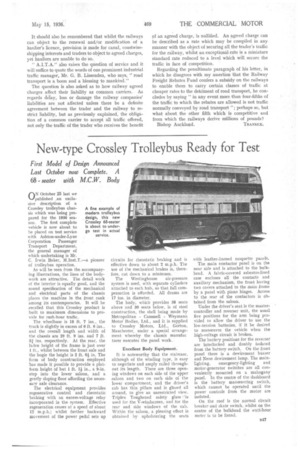New-type Crossley Trolleybus Ready for Test
Page 65

If you've noticed an error in this article please click here to report it so we can fix it.
First Model of Design Announced Last October now Complete. A 68seater with M.C.W. Body rIN October 25 last we ',./published an exclusive description of a Crossley trolleybus chassis which was being prepared for the 1936 season. The first complete vehicle is now about to be placed on test service with Ashton-under-Lyne Corporation Passenger Transport Department, the general manager of which undertaking is Mr. C. Irwin Baker, M.Inst.T.—a pioneer of trolleybus operation.
As will be seen from the accompanying illustrations, the lines of the bodywork are attractive. The detail work of the interior is equally good, and the sound specification of the mechanical and electrical parts of the chassis places the machine in the front rank among its contemporaries. It will be recalled that this Crossley product is built to maximum dimensions to provide for rush-hour traffic.
The wheelbase is 18 ft. 7 ins., the track is slightly in excess of 6 ft. 6 ins., and the overall length and width of the chassis are 29 ft. 9 ins. and 7 ft. 5/ ins. respectively. At the rear, the laden height of the frame is just over 1 ft., whilst between the front axle and the bogie the height is 2 ft. Oi in. The form of body construction employed has made it possible to provide a platfoim height of but 1 ft. l in., a 9-in. step into the lower saloon, and a gently sloping floor affording the necessary axle clearance.
The electrical equipment provides regenerative control and rheostatic braking with an excess-voltage relay incorporated in the system. Effective regeperation ceases at a speed of about 12 m.p.h.; whilst further backward movement of the power pedal sets up
A fine example of modern trolleybus design, this new Crossley 68-seater Is about to undergo test in actual service.
circuits for rheostatic braking and is effective down to about 2 m.p.h. The use of the mechanical brakes is, therefore, cut down to a minimum.
The Westinghouse air-pressure system is used, with separate cylinders attached to each hub, so that full compensation is afforded. All drums are 17 ins, in diameter.
The body, which provides 38 seats above and 30 seats below, is of steel construction, the shell being made by Metropolitan Cammell Weymann Motor Bodies, Ltd., and it is supplied to Crossley Motors, Ltd., Gorton, Manchester, under a special arrangement whereby the chassis rnanufac turer executes the panel work.
Excellent Body Equipment.
It is noteworthy that the staircase, although of the winding type, is easy to negotiate and amply railed throughout its length. There are three opening windows on each side of the upper saloon and two on each side of the lower compartment, and the driver's cab has thin pillars and is glazed all around, to give an unrestricted view. Triplex Toughened safety glass ''is used for the V-windscreen, and for the rear and side windows of the cab. Within the saloon, a pleasing effect is obtained by upholstering the seats
with leather-framed moquette panels.
The main contactor panel is on the near side and is attached to the bulkhead. A fabric-covered asbestos-lined case encloses ail the contacts and auxiliary mechanism, the front having two covers attached to the main frame by a panel with piano hinges. Access to the rear of the contactors is obtained from the saloon.
Under the driver's seat is the mastercontroller and reverser unit, the usual five positions for the arm being provided to allow the driver to use the low-tension batteries, if it be desired to manceuvre the vehicle when the high-voltage circuit is broken.
The battery positions for the reverser are interlocked and doubly isolated from the battery switch. On the front panel there is a dewirement buzzer and Neon dewirement lamp. The mainlighting, emergency-lighting and motor-generator switches are all conveniently mounted on a mahogany panel. In the centre of the dashboard is the battery manceuvring switch, which cannot be operated until the power controls from the motor are isolated.
On the roof is the normal circuit breaker and skate switch, whilst on the centre of the bulkhead the watt-hour meter is to be found.




































































































